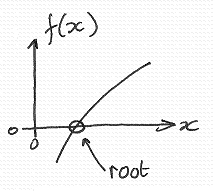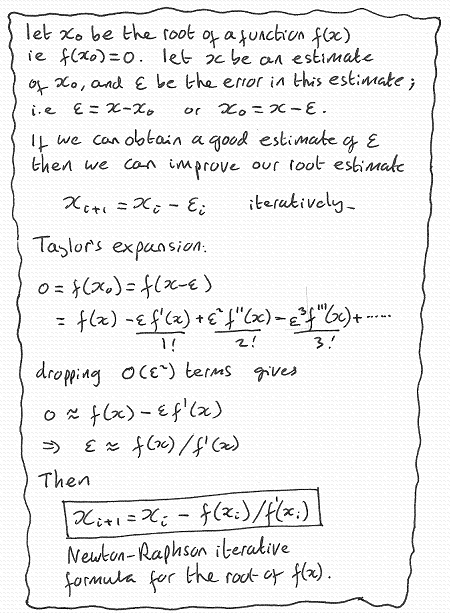http://cpp.gantep.edu.tr
C++ resources. Faculty of Engineering, University of Gaziantep
Last modified: Sat, 31 Oct 2009 10:13:41 +0200
Complete: ##################-- (90%)
Roots of a function f(x) |
1. The Newton Raphson Method 2. The Secant Method |
The root x0 of a function f(x) is such that f(x0)=0. Finding the root of a function analytically may be difficult and so a numerical solution may be necessary or simply convenient. The following sections describe two methods for find roots numerically, both are based on iterating improvements on an initial estimate of the root until the estimated error is less than a predetermined tolerance (required accuracy).
1. The Newton Raphson Method
nmprimer-NewtonRaphson.cpp: Newton-Raphson method for finding roots of a function.
1: 2: 3: 4: 5: 6: 7: 8: 9: 10: 11: 12: 13: 14: 15: 16: 17: 18: 19: 20: 21: 22: 23: 24: 25: 26: 27: |
// Newton-Raphson method for the root of f(x)
// Analytically the solution is x^3-28 = 0
// => x = 28^(1/3) = 3.0365889718756625194208095785057...
#include <iostream>
#include <iomanip>
#include <cmath>
using namespace std;
double f(double x) { return x*x*x-28.; } // The function f(x)
double d(double x) { return 3*x*x; } // The derivative of f(x)
int main() {
double x=3.5, Tolerance=1.0E-12;
cout << setprecision(18) << fixed;
do {
double Error = f(x) / d(x); // Estimate the error
cout << "Root = " << x << " Error = " << Error << endl;
if ( abs(Error) < Tolerance ) break; // Terminate if the tolerance is satisfied
x = x - Error; // Subtract the error estimate
} while(1);
} |
Root = 3.500000000000000000 Error = 0.404761904761904767 Root = 3.095238095238095344 Error = 0.057544848314079300 Root = 3.037693246924015877 Error = 0.001103873666278150 Root = 3.036589373257737812 Error = 0.000000401382022117 Root = 3.036588971875715526 Error = 0.000000000000053042 |
The error estimated calcuated as Error = f(x) / f'(x) provides very fast convergence
with the number of correct significant figures typically doubling on each interation.
The derivation of this method is given below:

2. The Secant Method
nmprimer-SecantMethod.cpp: Secant Method for finding roots of a function.
1: 2: 3: 4: 5: 6: 7: 8: 9: 10: 11: 12: 13: 14: 15: 16: 17: 18: 19: 20: 21: 22: 23: 24: 25: 26: 27: |
// Secant Method for the root of f(x)
// Analytically the solution is x^3-28 = 0
// => x = 28^(1/3) = 3.0365889718756625194208095785057...
#include <iostream>
#include <iomanip>
#include <cmath>
using namespace std;
double f(double x) { return x*x*x-28.; } // The function f(x)
int main() {
double x2=3.5, x1=3.6, Tolerance=1.0E-12;
cout << setprecision(18) << fixed;
do {
double Error = (x2-x1)/(f(x2)-f(x1))*f(x2); // Estimate the error
cout << "Root = " << x2 << " Error = " << Error << endl;
if ( abs(Error) < Tolerance ) break; // Terminate if the tolerance is satisfied
x1 = x2; // Improve x1
x2 = x2 - Error; // Improve x2
} while(1);
} |
Root = 3.500000000000000000 Error = 0.393414440624173245 Root = 3.106585559375826922 Error = 0.060452490895290242 Root = 3.046133068480536554 Error = 0.009327881945536839 Root = 3.036805186534999645 Error = 0.000215536543532409 Root = 3.036589649991467077 Error = 0.000000678067522840 Root = 3.036588971923944058 Error = 0.000000000048281500 Root = 3.036588971875662679 Error = 0.000000000000000128 |
The derivation of this method is given below:

Complete: ##################-- (90%)